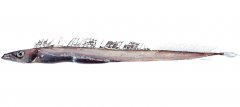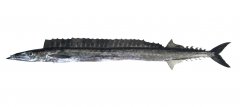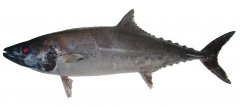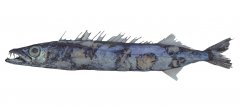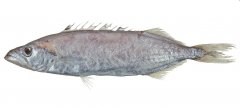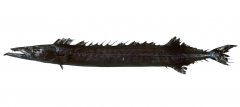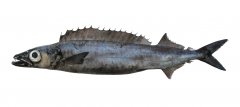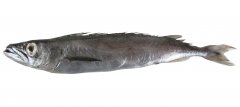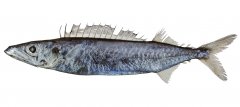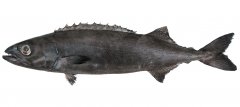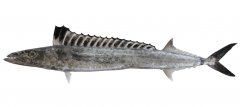Snake mackerels
Characteristic features:
Keys:
Key adapted from Nakamura & Parin, 20011.
Key to species
-
- Dorsal-fin elements >60; distance from anus to anal-fin origin much greater than eye diameter (Fig. 1a) Diplospinus multistriatus
- Dorsal-fin elements <56; distance from anus to anal-fin origin less than or about equal to eye diameter (Fig. 1b) 2
-
- Caudal peduncle with a prominent keel and 2 small keels above and below (Fig. 2a); dorsal-fin spines 8–9; lateral line single, extremely undulating (Fig. 3a) Lepidocybium flavobrunneum
- Caudal peduncle without keels (Fig. 2b); dorsal-fin spines more than 7; lateral line single, or bifurcated but not undulating (Fig. 3b) 3
-
- Skin very rough, scales medium sized, interspersed with spinous bony tubercles (Fig. 4a); midventral (abdominal) keel on belly (Fig. 5); lateral line single, obscure (Fig. 6a) Ruvettus pretiosus
- Skin comparatively smooth, scales small, not interspersed with spinous bony tubercles (Fig. 4b); no midventral (abdominal) keel on belly; lateral line single or double, always obvious (Fig. 6b) 4
-
- Two free anal-fin spines behind anus, the first large and dagger-shaped (Fig. 9a); lateral line almost straight (Fig. 10a); dorsal-fin spines 20–21 Nealotus tripes
- No free anal-fin spines behind anus (Fig. 9b); lateral line curved abruptly downward anteriorly (Fig. 10b); dorsal-fin spines 17–18 Promethichthys prometheus
-
- Body depth 14.5–19 times in standard length (Fig. 11a); dorsal-fin spines 26–32; dorsal and anal finlets 5–7 (Fig. 12a); both lateral lines originating at one point at upper edge of opercle (Fig. 13a) Gempylus serpens
- Body depth 5–8 times in standard length (Fig. 11b); dorsal-fin spines 17–19; dorsal and anal finlets 2–3 (Fig. 12b); lower lateral line branching off below third to seventh dorsal-fin spines (Fig. 13b) 8
-
- Base of first dorsal fin 2.2–2.6 times longer than base of second dorsal fin (including finlets) (Fig. 14a) Rexea prometheoides
- LBase of first dorsal fin 2.7–3.4 times longer than base of second dorsal fin (including finlets) (Fig. 14b) Rexea bengalensis
-
- Lateral line single (Fig. 15a) Nesiarchus nasutus
- Lateral line double (Fig. 15a) 10
-
- Dorsal-fin spines 17–19; cartilaginous processes on jaws (Fig. 16a); lower lateral line running along midbody (Fig. 17a) Thyrsitoides marleyi
- Dorsal-fin spines <16; no cartilaginous processes on jaws; lower lateral line running near ventral contour (Fig. 17b) Neoepinnula orientalis
Similar families:
Scombridae
Tunas & Mackerels

Scombridae differ in having silver, white and blue colouration, (vs. brown, black or silver, rarely blue-brown); often with distinct markings on body in the form of spots, bars, lines and stripes (vs. no distinct markings on body) and keels on caudal peduncle (vs. no keels present, except in Lepidocybium flavobrunneum).
Species:
References:
- Nakamura, I. and Parin, N.V. Gempylidae in: Carpenter, K, Niem, V. FAO species identification guide for fishery purposes. The living marine resources of the Western Central Pacific. Volume 6. Bony fishes part 4 (Labridae to Latimeriidae), estuarine crocodiles, sea turtles, sea snakes and marine mammals.. Rome: FAO; 2001; Volume 6:3381-4218.
×
![]()
